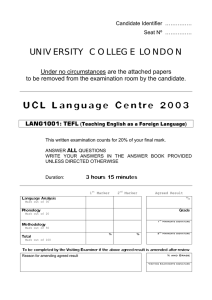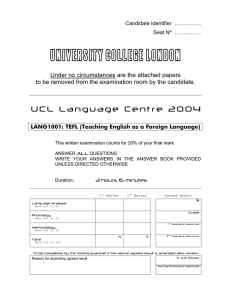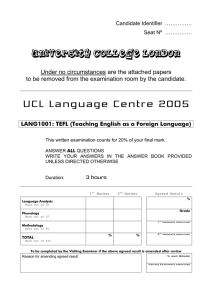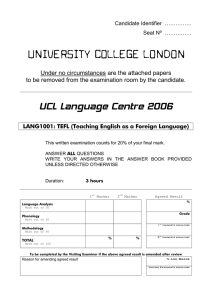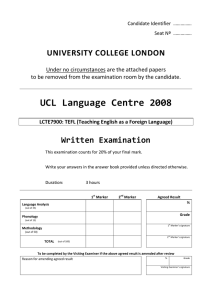UNIVERSITY COLLEGE LONDON
advertisement
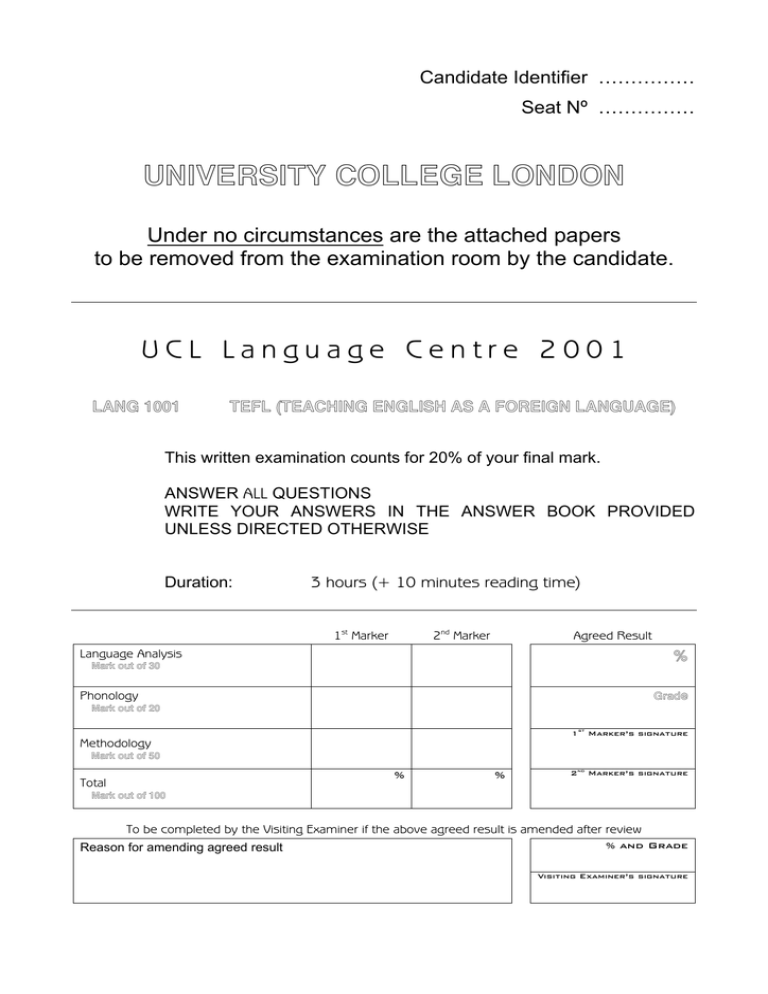
Candidate Identifier …………… Seat Nº …………… UNIVERSITY COLLEGE LONDON Under no circumstances are the attached papers to be removed from the examination room by the candidate. UCL Language Centre 2001 LANG 1001 TEFL (TEACHING ENGLISH AS A FOREIGN LANGUAGE) This written examination counts for 20% of your final mark. ANSWER ALL QUESTIONS WRITE YOUR ANSWERS IN THE ANSWER BOOK PROVIDED UNLESS DIRECTED OTHERWISE Duration: 3 hours (+ 10 minutes reading time) 1st Marker 2nd Marker Agreed Result Language Analysis % Mark out of 30 Phonology Grade Mark out of 20 1st Marker’s signature Methodology Mark out of 50 % Total % 2nd Marker’s signature Mark out of 100 To be completed by the Visiting Examiner if the above agreed result is amended after review Reason for amending agreed result % and Grade Visiting Examiner’s signature TEACHING ENGLISH AS A FOREIGN LANGUAGE – LANG 1001 SECTION 1 LANGUAGE ANALYSIS Page 1 65 Minutes In this section you can obtain a maximum of 30 points. Answer all questions in the answer booklet provided. Note form is acceptable for this section. 1. Read this short letter. Unfortunately, Silvia makes some mistakes. Find the mistakes, correct them and explain why they are wrong. There are no spelling or punctuation mistakes. There are 11 mistakes, including the example. The example has been done for you. Dear Natsuko, Thank you for yours (1) letter. It was great to hearing from you after so long. I’m really pleased that you visit me at long last! January is a good month because it’s quiet but remember that it must be cold so you will need to bring the warm clothes. I’m not sure if there will be a lot of time to visit other places but perhaps we’ll can visit Oxford which is one of the most beautiful cities in Britain. I think it’s much beautiful than Cambridge although you may disagree! If you will arrive on Saturday, we’ll have time to go in Sunday. I’m looking forward to your visit for so long time that I can’t believe that you’ll actually be here in a few weeks. Love Silvia (1) EXAMPLE. CORRECT FORM: It should be 'your letter'. The possessive adjective is needed because it is used with a noun. (10 points) TURN OVER TEACHING ENGLISH AS A FOREIGN LANGUAGE – LANG 1001 SECTION 1 2. Page 2 (continued) (a) Look at the conversation below. Identify and name the FOUR question types that are used. (b) Give a brief description of how they are formed in this passage. (c) Write 2 concept questions for each question identified. (d) Explain 1 problem that learners can have with the FORM and 1 problem that they can have with PRONUNCIATION of each question. A: Hello Sue. I haven’t seen you for ages. What have you been doing with yourself? B: Well, I’ve just come back from this amazing holiday in Thailand. Have you ever been there? A: No, never. It’s very hot at this time of year, isn’t it? B: Yes, but most buildings have air conditioning. Do you know what it was called a hundred years ago? A: Yes, of course. Everyone knows that! B: Well, I didn’t! (15 points) 3. What does each of the following groups of words have in common and what problems of form, meaning and pronunciation could they cause learners? (a) suspicion, suspicious, a suspect, to suspect. (b) afford, cost, borrow, lend. (5 points) TURN OVER TEACHING ENGLISH AS A FOREIGN LANGUAGE – LANG 1001 SECTION 2 PHONOLOGY Page 3 25 Minutes In this section you can obtain a maximum of 20 points. 1. Connected Speech (a) Mark the following dialogue for LINKING ONLY. WRITE ON THE DIALOGUE ITSELF. EXAMPLE: A What’s N up? B I don’t believe it. The oil tank’s down again! A Can’t we economise more? Oil’s expensive these days. B I can but can you? You’re so extravagant. You leave the heating on all night sometimes. A Someone from Area Office was asking about holiday plans last week. So if we’re going to Mallorca in June, we’d both better be careful! (5 points) TURN OVER TEACHING ENGLISH AS A FOREIGN LANGUAGE – LANG 1001 SECTION 2 Page 4 (continued) Assimilation eg standby / 0stæmbaI / and ten minutes / te0mInIts / is one feature of connected speech in English. (b) Name FIVE other features of connected speech in English and identify TWO examples of each feature in the following dialogue. NB: Do not give more than 2 examples for each feature as only the first 2 will be accepted. Sentence stress and intonation are not included in this question. WRITE ON THE DIALOGUE ITSELF. A I think I’ll have to negotiate another loan soon B Where d’you hope to get it from? A From the bank on the campus, I suppose. They’re reasonable. B What happened with that job you applied for? A Oh, someone else got it. B Pity. Couldn’t you ask for a second interview? There may be more than one job on offer. (10 points) TURN OVER TEACHING ENGLISH AS A FOREIGN LANGUAGE – LANG 1001 SECTION 2 2. Page 5 (continued) Sounds (a) Transcribe the following individual words into phonemic script. Mark the stress. transfusion (b) thrived What PRONUNCIATION problems might learners have with these words? (5 points) TURN OVER TEACHING ENGLISH AS A FOREIGN LANGUAGE – LANG 1001 SECTION 3 METHODOLOGY Page 6 90 Minutes In this section you can obtain a maximum of 50 points. Answer ALL questions. 1. You have a group of UPPER INTERMEDIATE learners who need to revise and practise the first and second conditionals. You decide to use the enclosed reading material as the basis for your lesson. How would you use the material to revise this language area and give oral and written practice? There are ten learners in the class and the lesson is SIXTY MINUTES. Include a BRIEF lesson plan. (20 points) 2. Your learners (INTERMEDIATE) have asked to learn vocabulary for INFORMATION TECHNOLOGY (for example, modem, computer terminal) and TELEVISION (for example, programme, soap opera). (a) Choose ONE of these lexical areas and list the items you would teach. (b) Describe how you would teach them and provide sufficient oral practice in a FORTY MINUTE lesson. Include a BRIEF lesson plan. (15 points) 3. Read the statements below. Choose TWO of them and BRIEFLY discuss them. Use examples to illustrate your ideas. (a) What factors determine the approach you use to present/revise language? (b) What kinds of tasks can you use to give learners speaking practice and why? (c) In what ways can you use visuals to help learners? (d) How can you make sure that learners understand the meaning of vocabulary? (15 points) TURN OVER TEACHING ENGLISH AS A FOREIGN LANGUAGE – LANG 1001 SECTION 3 Page 7 (continued) Language in Use – Upper Intermediate, Adrian Doff and Christopher Jones CUP 1997 END OF PAPER
